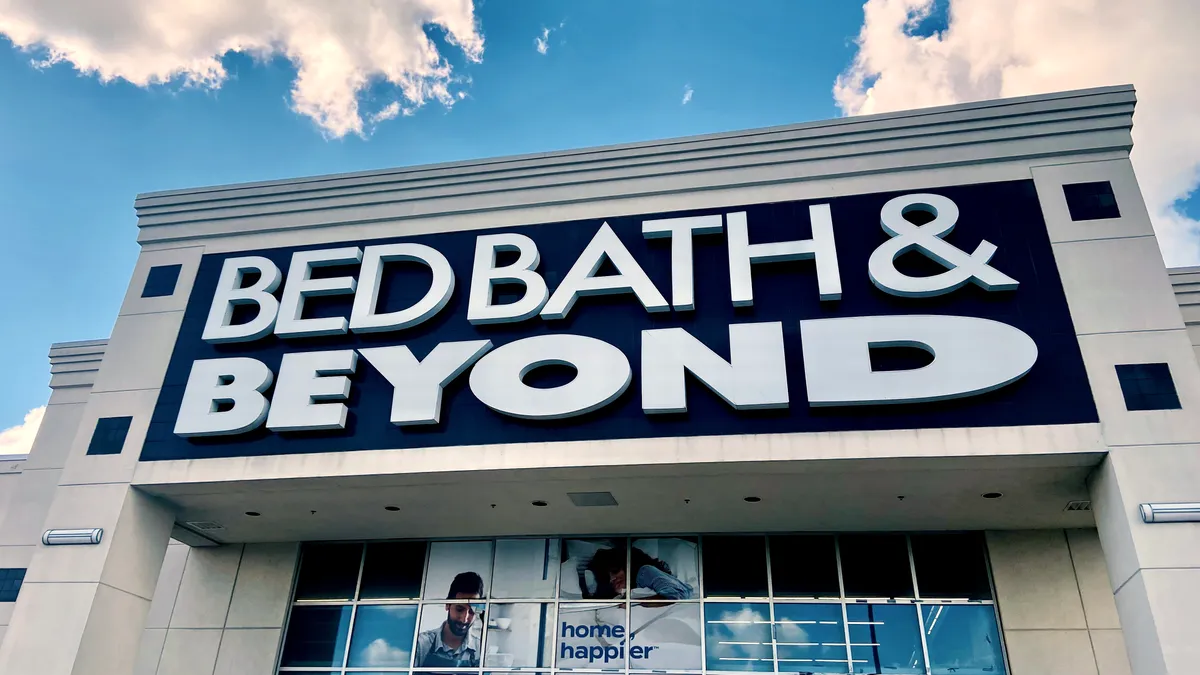Dive Brief:
- Beyond Inc.’s third-quarter net revenue fell 16.6% to $311 million from $373 million a year ago, the company said in a Thursday press release. Gross profit was 21% of revenue, declining to $66 million, down 20% from $83 million a year ago.
- The company’s net loss narrowed 3.2% to $61 million from $63 million a year ago. However, Beyond posted an operating loss of $43.5 million for the quarter, up 6.4% from $41 million a year ago.
- The company said it had 6 million active customers, a 21% year over year increase. It delivered 1.6 million orders, a 19% decrease from a year ago and the average order value rose slightly to $199, up from $192 the prior year.
Dive Insight:
Beyond is working to transform itself from an asset-light business to a technology driven, affinity and data-based monetization model supported by a collection of brands, Marcus Lemonis, the company’s chairman, said in a Thursday statement.
Still, “the third quarter numbers continue to look very shabby,” Neil Saunders, managing director of GlobalData, said in emailed comments to Retail Dive. “Sales are down again this quarter and that follows a sharp drop in the prior year. On a two year basis, sales have cratered by 47.8% despite the fact Beyond has acquired other brands and is now a larger company. Losses continue to mount.”
Just a day before the company’s earnings release, Beyond disclosed in a regulatory filing that it plans to layoff 20% of its workforce in the upcoming fourth quarter. Chief Product Officer Carlisha Robinson was also terminated without cause earlier this week as part of the workforce reduction. The job cuts are expected to generate $20 million in annualized savings. The company also recently sold its Utah corporate headquarters property for $55 million.
Beyond is the parent company of Bed Bath & Beyond, Overstock, Zulily and other home decor brands.The current corporate entity is about 18 months old, formed following the 2023 bankruptcy of the old Bed Bath & Beyond and through the acquisition of various brands and intellectual properties.
Dave Nielsen, Beyond’s president, said the company has identified four areas of improvement — marketing efficiency, sales growth, margin and expense management.
By creating a more variable and leveraged cost structure to support evolving business needs, “all in, we expect to have reduced our fixed expense base by an annualized $65 million heading into 2025,” Chief Financial and Administrative Officer Adrianne Lee said in a statement. In the first nine months of the year, Beyond has recorded about $1.09 billion in net revenue, a 7% decline from the prior year, a nearly 25% decline in gross profits from a year ago to $220.5 million and a net loss of $177.5 million as of Sept. 30.
“We are still in the early innings of creating a robust data cooperative that will serve as the affinity and loyalty program foundation, and having recently announced partnerships with both The Container Store and Kirkland’s Home, we are well on our way,” Lemonis said. “What we are ultimately building at Beyond is intended to leverage the combined strengths of all involved parties, driving improved financial performance and shareholder value.”
Under a strategic partnership deal with The Container Store, announced Oct. 15, Beyond plans to invest $40 million for a 40% stake in the company. The deal will include an offering of Bed Bath & Beyond products at Container Store locations.
Kirkland’s Home will be the exclusive operator and licensee in a pilot to open up to five small format neighborhood Bed Bath & Beyond stores, in a deal announced earlier this week. Beyond will invest $25 million in the retailer. The Kirkland’s-Beyond partnership also includes a seven year collaboration agreement in which Beyond stands to earn incentive and store royalty fees.
“Admittedly, the home furnishings category is soft which is very unhelpful to Beyond,” Saunders said. “However, the company is under performing the market and there is a general sense that it has not built a winning proposition. One of the problems is that as an online only brand it lacks visibility with consumers and often gets overlooked. This is one of the reasons why these new partnerships, which bolster its presence in the physical space, are important. Whether they work remains to be seen.”













